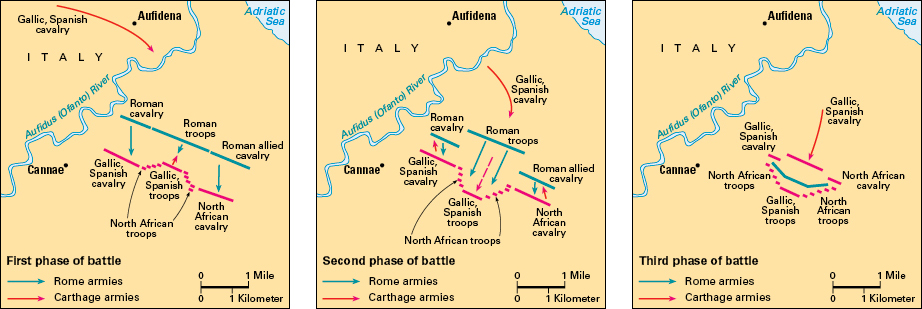Cannae, Battle of, << KAN ee or KAN eye, >> was a historic battle between the armies of Rome and Carthage. The battle took place on Aug. 2, 216 B.C., in what is now southeastern Italy. Carthage was an ancient city and the center of an empire. It was near the site of present-day Tunis, Tunisia. The battle was one of the worst military defeats in Roman history and the low point for the Romans in the Second Punic War (218-201 B.C.). Hannibal, a powerful general and statesman of Carthage, led his army to victory in the battle but ultimately lost the war.

In 218 B.C., Hannibal’s army had crossed the Alps from his base in Spain and invaded northern Italy. Hannibal won a series of great victories in northern Italy. However, he failed to force the Romans to accept defeat in the war. Hannibal then bypassed Rome and traveled south. He hoped to spark a rebellion by Rome’s allies in southern Italy.

By 216 B.C., the Romans had gathered an army of about 80,000 men to fight Hannibal. The Roman army was led by Lucius Aemilius Paullus and Gaius Terentius Varro. It heavily outnumbered Hannibal’s forces. Hannibal’s army totaled less than 50,000. It consisted of Carthaginians and other North Africans, Spaniards ruled by Carthage, and Gauls from northern Italy. The two armies met near the town of Cannae, near the mouth of the Aufidus River, now called the Ofanto, in southeastern Italy.
In a famous military maneuver, Hannibal thinned out the center of his front line and made it bulge toward the enemy. After the two armies had engaged, Hannibal’s front line gradually fell back. This action drew the Romans into a sort of pocket with Hannibal’s forces surrounding them on three sides. Hannibal’s cavalry, positioned on the wings of his forces, defeated the Roman cavalry. The Carthaginian cavalry then hemmed in the remaining Roman forces on the fourth side. Hannibal’s forces probably lost up to 8,000 men and killed about 30,000 to 50,000 Romans and Roman allies. Cannae was one of the bloodiest battles ever fought on European soil.
Hannibal hoped that his overwhelming victory at Cannae would encourage much of Italy to revolt against Roman rule, and thus force Rome to submit to Carthage. But the rebellion that developed remained confined to a few rebel strongholds in the south, and the Romans remained defiant. Hannibal finally had to leave Italy in 203 B.C. to face a Roman invasion of Carthage. Since ancient times, historians have debated whether Hannibal could have won the Second Punic War by marching directly on Rome.
See also Hannibal ; Punic Wars .
